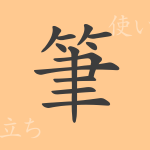In the rich tapestry of Japanese written culture, 常用漢字(jouyou kanji) are fundamental elements that form the basis of communication. Among these, the kanji “泌(hi)” is occasionally used in everyday life and specialized contexts. However, due to its infrequent usage, not many people might fully understand its meaning and application. This article aims to shed light on the kanji “泌(hi)” from its origin and meaning to its usage, including idioms and phrases that incorporate it.
Origin of 泌(hi)
The kanji “泌(hi)” originates from the character “泉(sen),” which represents water springing from the ground. In ancient China, the natural emergence of water onto the surface was metaphorically linked to the secretion of liquids from within the body. From this perspective, “泌(hi)” came to symbolize the movement of liquids from the inside to the outside.
Meaning and Usage of 泌(hi)
The kanji “泌(hi)” is primarily used to mean “secretion.” In medical contexts, it refers to the phenomenon of liquids produced within the body being released from specific organs or tissues. In everyday expressions, it can also describe something oozing or seeping from within. For example, it can be used in phrases like “汗を泌(hi)る” (to sweat) or “光を泌(hi)く” (to emit light).
Reading, Stroke Count, and Radical of 泌(hi)
Understanding the reading and structure of the kanji “泌(hi)” can deepen one’s comprehension of it.
- Reading: The On’yomi (音読み) is “ヒ(hi),” and the Kun’yomi (訓読み) is “ひ(hi)・する(suru).”
- Stroke count: It has a total of 8 strokes.
- Radical: The radical is 水部(sanzui), which signifies water.
Idioms, Phrases, and Proverbs Using 泌(hi) and Their Meanings
Idioms and phrases that include “泌(hi)” often provide a more concrete illustration of its meaning. For instance, “分泌物(bunpibutsu)” refers to a liquid produced within the body, and “分泌腺(bunpisen)” denotes the organ that secretes this liquid. Additionally, “泌尿器科(hinyoukika)” means urology, a medical specialty related to urinary organs. These terms are predominantly used in medical and biological fields.
Summary of 泌(hi)
The kanji “泌(hi)” is used to depict the movement of something from the inside to the outside, as indicated by its form and meaning. In medical contexts, it refers to the secretion of bodily fluids, while in everyday language, it can also be used metaphorically. Understanding and appropriately using this kanji can enrich one’s expression. Through this overview, we hope to deepen your understanding of “泌(hi)” and enhance your comprehension and usage of the Japanese language.

























